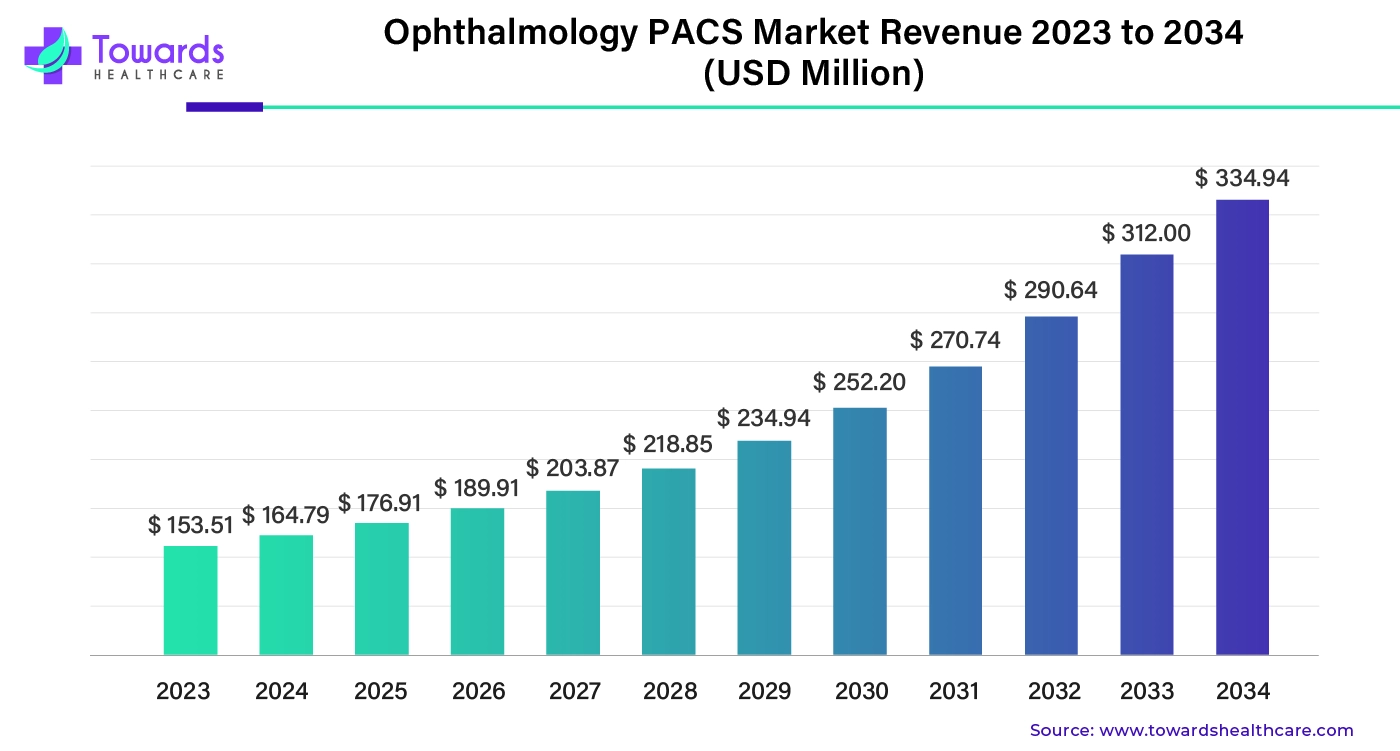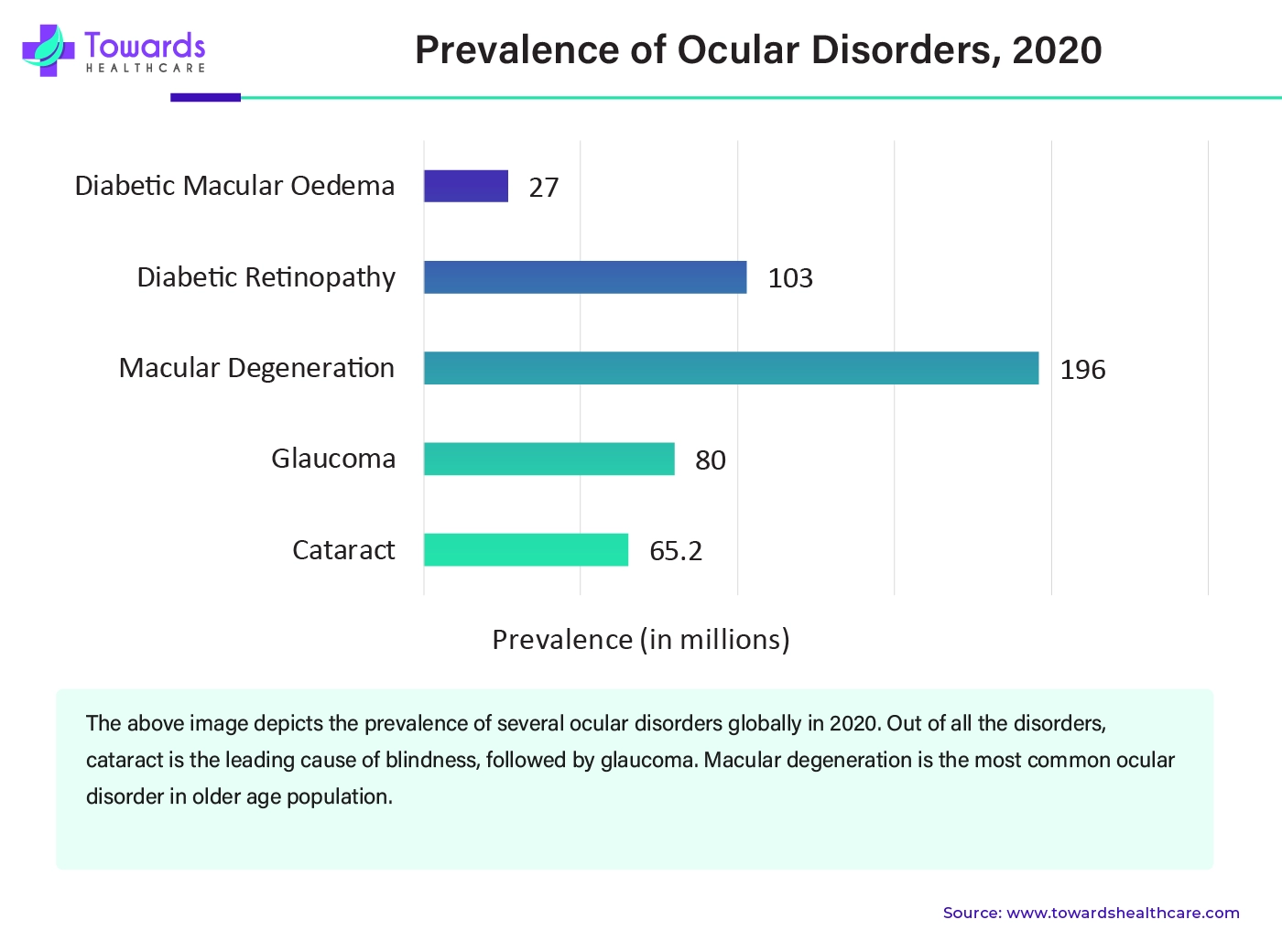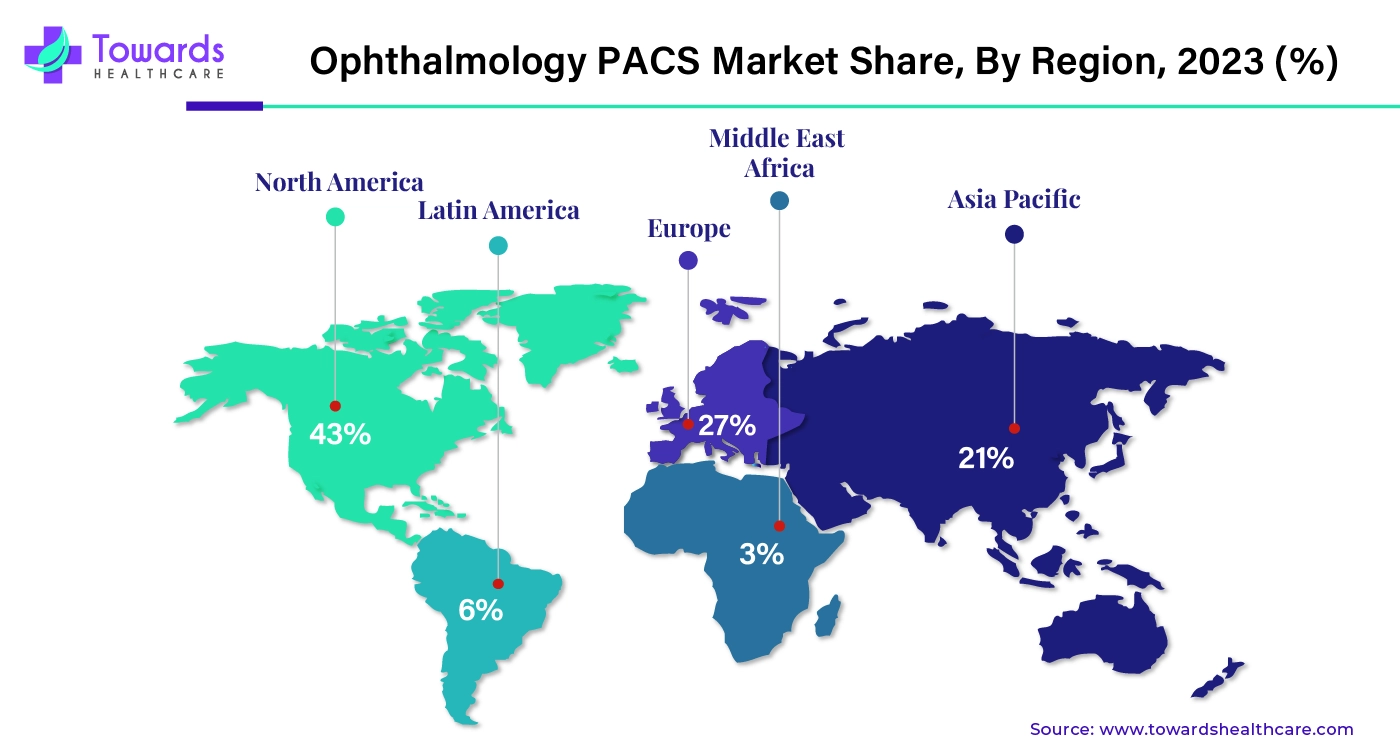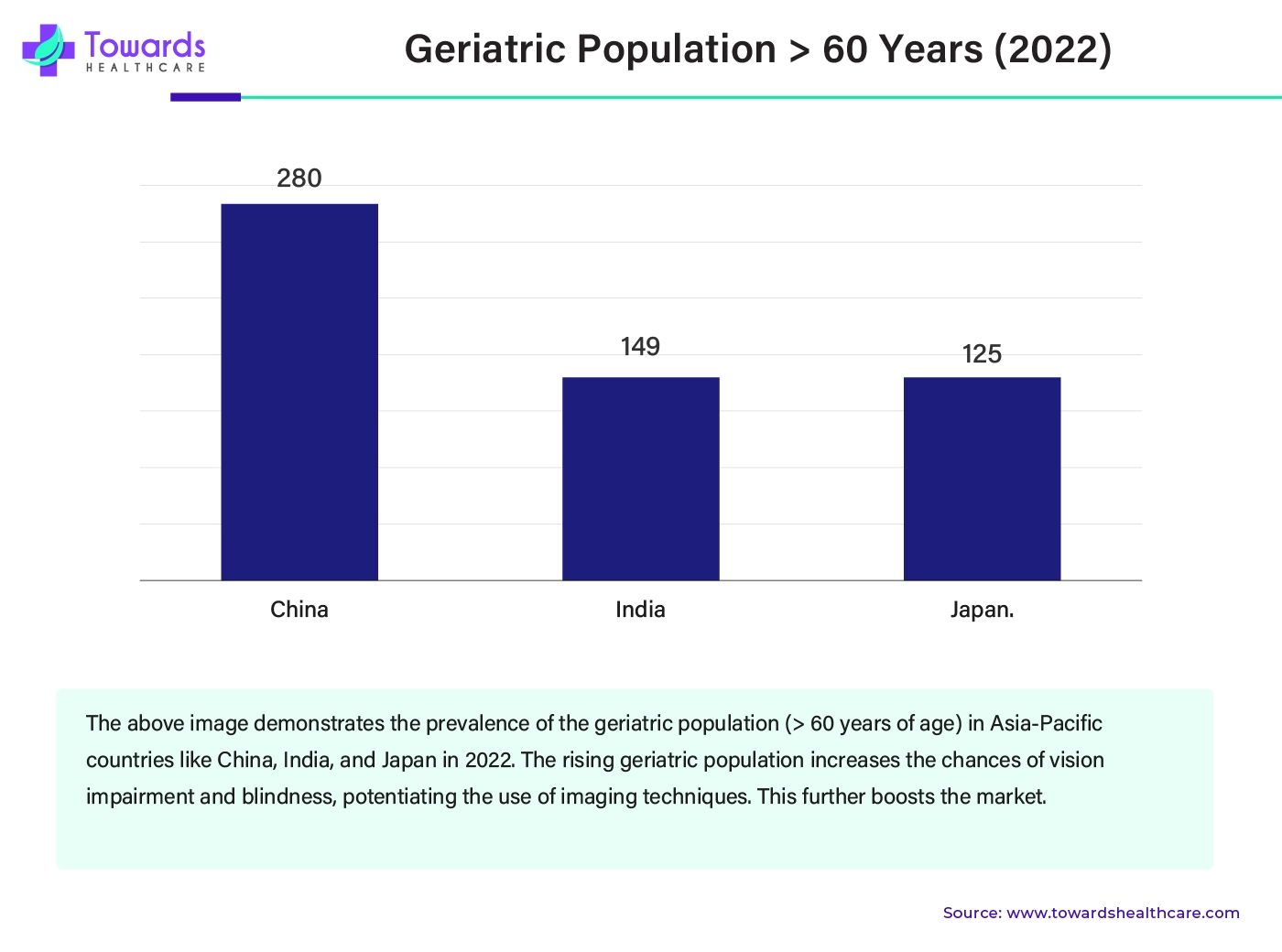April 2025

The ophthalmology PACS market was estimated at US$ 153.51 million in 2023 and is projected to grow to US$ 334.94 million by 2034, rising at a compound annual growth rate (CAGR) of 7.35% from 2024 to 2034. The rising incidences of ocular disorders like cataracts and glaucoma, increasing ocular surgeries, and advanced healthcare infrastructure drive the market.

Picture Archiving and Communication System (PACS) is a medical imaging technology used to store, share, retrieve, and access medical images and clinically relevant reports. PACS is a technology to digitally transmit electronic images and reports, eliminating the need for physical copies like films and files. The digital format for PACS is the Digital Imaging and Communications in Medicine (DICOM). Images from various medical imaging instruments like X-rays, MRI, CT scans, endoscopy, mammograms, ophthalmology, digital radiology, etc. can be stored and secured. These images can be accessed anytime and anywhere using a single software. PACS is widely used by ophthalmologists as they can view imaging results on all workstations in the network. They can also look at a summary of all studies or just some of the results in a different configuration.
Artificial Intelligence (AI) revolutionizes the healthcare sector by integrating advanced technologies. The integration of AI with PACS has potential benefits for both the physicians and the patients. AI has the potential to automate monotonous processes like report preparation and image annotation. AI can assist ophthalmologists by analyzing and interpreting vast amounts of medical images. This can improve the speed and accuracy of diagnoses and help ophthalmologists in the decision-making process. This reduces the workload on the ophthalmologist and facilitates precise treatment outcomes. Additionally, AI in PACS can provide tailored treatment plans for individual patients.
For instance,
| Company Name | PaxeraHealth Corp |
| Headquarters | Boston, Massachusetts, United States |
| Recent Development | In December 2022, PaxeraHealth announced the closure of its series A funding round led by Sopris Capital. The investment will enable PaxeraHealth to rapidly increase healthcare demand for medical imaging AI algorithms and promote the company’s growth. |
| Company Name | Aycan Medical Systems |
| Headquarters | Rochester, New York, United States |
| Recent Development | In April 2024, Aycan, a leading medical imaging manufacturer, announced the launch of Aycan mini PACS. The mini PACS is specially designed for smaller clinics and healthcare systems, providing a manageable and cost-effective way to store data. |
The rising prevalence of ocular disorders like cataracts, glaucoma, macular degeneration, diabetic retinopathy, diabetic macular edema, etc., globally necessitates early detection and treatment of these disorders. The rise in the geriatric population and patients with comorbidities increases the prevalence of ocular disorders. This promotes the use of various ocular imaging techniques like optical coherence tomography (OCT), photoacoustic imaging, ultrasound biomicroscopy, etc. PACS ameliorates the data sharing, data storing, and retrieving of these imaging outcomes. The American Association of Ophthalmology believes that ocular imaging manufacturers should support standardized DICOM format for data sharing and interoperability rules. The use of this technology benefits both the ophthalmologist and the patients by improving workflow efficiency and patient care.

The major challenge faced by the PACS system is data security and privacy. The patient’s healthcare data and report can be hacked, breaching data security measures and privacy regulations. The lack of privacy prevents patients from adapting to the system. A security breach may lead to loss of patient trust, serious legal complications, and significant financial fines. Another major challenge is the resistance by healthcare professionals to advanced techniques and the lack of training to operate the system. Additionally, interoperability with existing systems can pose challenges as different departments may use different software and diverse imaging devices, making seamless integration a complex task.
The integration of technology with the PACS systems can prove to be beneficial to both ophthalmologists and patients. PACS can be integrated with advanced technology, allowing faster dissemination of patient information to physicians and providers. The demand for technological advancements increases due to the lack of skilled radiologists, especially in developing countries. It is estimated that in India, around 1.5 million scans are done each day, but there are less than 15,000 radiologists to study and report them, i.e., only one radiologist for every 100 scans. This potentiates the use of advanced technologies with PACS systems. The use of cloud-based systems is gaining traction as it improves workflow efficiencies and on-demand scalability. Additionally, automating workflows with electronic health records (EHRs) makes up the patient’s repository of health information, including medical images. EHR integration can improve data accessibility and collaboration between healthcare professionals.
By type, the integrated PACS segment held a dominant presence in the ophthalmology PACS market in 2023 and is expected to grow fastest during the forecast period. The integration of PACS with hospital information systems (HIS) or radiology information systems (RIS) provides numerous benefits to clinicians and radiologists, respectively. The integrated PACS system can overcome challenges like managing different systems for different patients, staff shortage issues, and order of radiology images of a patient. It provides access to a patient’s healthcare reports and data to doctors on their workstations. They offer automation to access clinical results, accounting, radiography, microbiology, lab pathology, and pharmacy, as well as patient registration and admission. Additionally, technological advancements necessitate the integration of AI with PACS. This further automates the process, improves workflow efficiency, and saves time.
By mode of action, the cloud-based system segment is anticipated to grow fastest in the ophthalmology PACS market during the forecast period. Cloud-based PACS systems provide superior benefits over on-premises systems. Cloud-based PACS runs on remote cloud computing services. These systems provide more storage and safer storage to store large files for a longer period. The patient’s report can be accessed from multiple healthcare locations, promoting collaboration among healthcare professionals and reducing the need for on-premises infrastructure. Additionally, unlike on-premises PACS systems, they do not require extra space in the clinic or radiology department. They offer scalability, catering to rapidly growing healthcare systems or imaging practices. Hence, the shift towards cloud-based systems is increasing to improve security and storage and to reduce the burden on IT staff to maintain the system.
For instance,
By end-user, the hospitals segment dominated the global ophthalmology PACS market in 2023 and is projected to expand rapidly in the market in the coming years. The demand for PACS systems in hospitals is high due to the huge number of patients, favorable infrastructure, and capital investment. PACS systems enable the sharing, storing, and retrieving of patient reports within different departments of a hospital in the network at any time. The growing number of ophthalmic imaging techniques and the resultant data volume boost the market.
For instance,
By region, North America held the largest share of the ophthalmology PACS market by 43% in 2023. The rising prevalence of ocular disorders, advanced healthcare infrastructure, increased collaborations, technological advancements, presence of key players, and government investments drive the market. The market is also driven by government initiatives and public-private partnerships across the US and Canada. The US government’s Vision Health Initiative (VHI) collaborates with many professional and community organizations, tribes, researchers, and community members to advance vision health equity. VHI’s Vision and Eye Health Surveillance System estimates the prevalence of vision loss, eye disorders, and eye care services. Additionally, the National Cybersecurity Center of Excellence (NCCoE) is an organization established by the U.S. government to analyze the risk factors regarding a PACS ecosystem. The organization uses a NIST Risk Management Framework to identify measures to safeguard the ecosystem.
For instance,

By region, Asia-Pacific is anticipated to grow fastest in the market during the forecast period. The increasing geriatric population, rising prevalence of ocular and chronic disorders, increased investments, government initiatives, and growing healthcare infrastructure drive the ophthalmology PACS market. Ocular disorders like glaucoma, cataracts, and age-related macular degeneration in countries like China, India, and Japan augment the market. India reported 11.9 million glaucoma cases, whereas the prevalence of age-related macular degeneration in people aged 50 years and above has been estimated to be 22.3%.
For instance,
In May 2023, Nandico, an Indian healthcare software company, launched a next-generation, cloud-based PACS system to improve turnaround time for radiology reports. The system was developed to enable radiologists and clinicians to view patient reports on any device at a low cost and within a short period.

By Type
By End-User
By Region
April 2025
January 2025
December 2024
December 2024